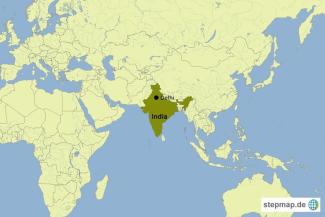Running dry
India’s water crisis

Several weeks ago, a special train carrying millions of liters of water made its last journey to the South Indian city of Chennai, home to more than 8 million people. This train made its first journey in July 2019, as the city was experiencing its worst drought in 70 years.
The situation in the city was dire, as its four reservoirs ran dry in mid-June. Some people living there were relying on government tankers to provide water. Others were paying large sums to private companies to get water to their homes.
Although the special trains have stopped running, India’s water crisis persists. According to a report by the government-run think-tank National Institute for Transforming India (Niti Aayog), the water-supply situation is "only going to get worse".
The report cautions that 21 major cities will run out of groundwater by 2020, including the national capital and the information technology hub Bengaluru (Bangalore). At the global level, India ranks thirteenth among the 17 countries where "water stress" is "extremely high".
Indian cities often run dry during the summer. The main reasons are lack of proper infrastructure to carry water to houses, water mismanagement and ever-increasing demand for groundwater supplies. The picture is bleak in both urban and rural areas.
In the northern state of Haryana, farmers have protested by taking public mud-baths to highlight the short supplies of clean water. In November 2018, farmers marched on the parliament in Delhi to highlight the problem.
Farmers increasingly depend on underground water sources. Apart from the short monsoon season, rivers have become dryer as their waters are used for irrigation or industrial purposes.
Groundwater makes up about 40 % of India's water supply. The country accounts for a quarter of global demand for groundwater and is more dependent on water pumped from aquifers than any other nation.
Today, there are more than 20 million bore wells (wells drilled into the earth for retrieving water) pumping water from the ground. That has contributed to a 61 % decline in the groundwater level between 2007 and 2017, according to India’s Central Water Commission, a technical organisation.
As a mitigation measure, Prime Minister Narendra Modi created the Ministry of Water and Sanitation last July to promote water management. In rural areas, the Ministry hopes to implement district water conservation plans, and to promote efficient water use and better crop choices. In urban areas, targets are being developed for reusing waste-water.
Meanwhile, the Aam Aadmi political party, inspired by the efforts of environmentalist and activist Aabid Surti, has been leading the effort to recruit volunteers in the national capital. Some community-level solutions include using WhatsApp groups to send messages about water conservation and organising volunteer groups to repair water leaks.
India is moving fast towards the day when taps will run dry across the country. Even if water supply only slows to a trickle, that will harm the quality of life of millions of people and impact economic development.
Roli Mahajan is a freelance journalist.
roli.mahajan@gmail.com










